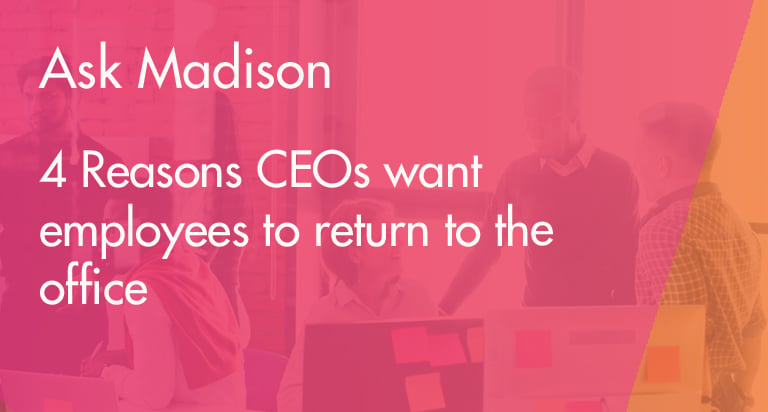Remote work has become the new standard of work—but not everyone agrees that this newer way of working is better—namely, old-school CEOs at large companies and in the tech world, like X (formerly Twitter), Meta, and Apple.
So why is there so much tension around remote work and leaders wanting employees back in the office? It depends who you ask.
Employees have come to appreciate the flexibility of remote work. They can work non-traditional hours, care for children at home, or run quick errands. Employees don't get distracted by water-cooler chatter in the office. Workers save hundreds of dollars by avoiding the commute and cutting childcare costs.
And after nearly every company implemented remote work policies in 2020, employees got used to working from home—and they don't want that to change.
"Returning to the office is likely to face stiff resistance from an emboldened workforce with a newly found taste for remote work and an expectation for work flexibility." - Johnny C. Taylor, Jr., President and CEO of SHRM
CEOs, on the other hand, can't wait for employees to return to the office. The 2023 KPMG CEO Outlook report revealed that:
- 87% of global leaders said they'll likely reward employees who work in the office with better salaries, projects, and promotions
- 64% of CEOs surveyed predict a return to the office within the next three years
Why are they so anxious to get workers back in the office? Let's find out.
4 Reasons CEOs are mandating return-to-office policies
Despite high tensions with their employees, many CEOs are unwavering in their stance on in-office work. Those mandating a return to office (RTO) believe it'll benefit everyone in the long run, from increased productivity to a stronger culture.
Let's explore four of the most common reasons CEOs want their employees back in the office.
1. They think employees are more productive in an office environment
One of the top reasons CEOs want their employees back in the office? They believe employees are more productive when they're together in an office. And the data has started to shift towards proving that assumption right.
According to the Bureau of Labor Statistics (BLS), in 2020 and 2021, employee productivity in the U.S. did rise. But in 2022, it fell by almost 2%. The U.S. workforce also experienced five consecutive quarters of declines in worker productivity—which has never happened before (since first collecting this data in 1948).
But why the sudden shift in productivity? EY-Parthenon chief economist Gregory Daco suggests the cause is multitasking. People often multitask when working from home, but that multitasking includes non-work-related tasks, like chores or running errands.
Another cause could be that top performers aren't in the office. Jake Wood, CEO of Groundswell, explained that "top performers raise the performance of those around them. This is severely degraded when those top performers (who are most capable of thriving remotely) are working from home. This renders much of the rest of the org operating in an insufficient capacity."
Whatever the cause, leaders are convinced bringing workers back to the office is the solution.
2. They think in-person collaboration and communication is more effective
Many outspoken leaders—like those at JP Morgan Chase and X—have touted the benefits of in-person collaboration and cited it as a driving force to return to a fully in-office way of work. Studies from Stanford suggest in-person teamwork is more effective: in-person teams generate between 15 and 20% more ideas than those working remotely—these ideas also earned higher ratings for originality.
Jonathan Levav, a marketing professor at Stanford's Graduate School of Business, revealed the science behind virtual collaboration (and why it's less effective): we focus on the narrower field of vision from a screen, which narrows our thinking, too. This restricted focus limits creative idea generation.
Multiple Gallup studies reveal that idea generation and collaboration are more effective in person. An analysis of 100,000+ business units showed that units with more bonded workers had higher performance levels. Bonding between employees was highest during in-person interactions.
Another reason in-person collaboration might be more effective relates to the synchrony of nonverbal and verbal cues. When we collaborate in person, we blend words with gestures, movements, eye contact, and other nonverbal communication that we can't replicate on-screen.
3. They think it fosters company culture
Culture used to be something only startups cared about. And it was often synonymous with casual dress, ping pong tables, beer on tap, and limitless snacks. But as company culture has evolved and employer branding has become a strategic initiative, CEOs are making the case that culture is built and fostered in the office.
SHRM summed up the value of culture (from a CEO perspective):
Stronger culture typically means a more engaged worker, and a more engaged worker is more productive.
And we all know that more productive employees drive profits. A study conducted by Harvard Business Review showed that companies with strong cultures saw revenues increase by four times as much as those with weaker cultures.
CEOs believe winning cultures that foster these results center around being physically together with colleagues.
- Employees can learn about and observe the culture from coworkers in the office
- Seeing your team face-to-face and collaborating in person can create a more trusting culture
- It's easier to bond with teammates in person
4. They think it allows for more training and career development
With nearly 90% of CEOs considering rewarding in-office employees with promotions and pay raises, remote workers may suffer from being out of the office. But, other factors could impact a remote employee's career progression.
For younger employees—like Gen Z—hands-on training and mentorship are crucial for their development. Their managers or more experienced colleagues can teach them directly or indirectly new skills and knowledge to help them progress. But that requires both inexperienced and more established employees to be on site.
A WFH Research study also uncovered an interesting fact: in-office workers spend 25% more time doing career development activities than their remote coworkers and nearly half an hour more on formal training. They also spend about 40 more minutes per week mentoring others.
CEOs want their teams to grow their skills and bring up the next generation of employees. And they're adamant that you need to be in the office to do it.
Find a balance
Requiring employees who have adapted their lives to a remote style of work is a big ask. But if you believe that in-office work is the best option, consider the impact on your employees before you mandate an RTO.
Get their input and listen. Give them a reason to want to be in the office, like commuter stipends or collaborative workspaces.
Need some more ideas on how to incentivize employees to come back to the office? Download our whitepaper.
 More and more organizations are desperate to get their employees back in the office—research backs it up. A survey from consulting firm KPMG found that nearly two-thirds of CEOs said fully in-office will be the ideal work environment at their companies in 2025.
More and more organizations are desperate to get their employees back in the office—research backs it up. A survey from consulting firm KPMG found that nearly two-thirds of CEOs said fully in-office will be the ideal work environment at their companies in 2025.
While the way we work has shifted, savvy companies are quickly figuring out how to blend the new normal with pre-existing foundations that will get their workforce back in the office.
The companies doing this understand that they need to incentivize their employees to do what they want—namely, return to the office. And these businesses are doing it by mimicking a rewards program, complete with all the perks.
We’ll explore how you can motivate your employees to come back to the office with a recognition program that puts their wants and needs front and center.
At Madison Recognition our work is rooted in the belief that unleashing the productive potential of employees with reward and recognition programs and empowering individuals will help us stay ahead of workforce trends. Want to learn? Download our white paper.



